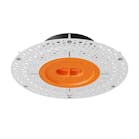Flicker is the problem certain lights have, exhibiting a subtle pulsating or strobing issue. It's barely noticeable by the human eye; however, more organizations are paying attention to flicker because it;s being implicated in triggering a host of health related issues such as epilepsy attacks, migraines, fatigue, reduced visual task performance, distraction and visual impairment.
The source of this problem is the power current, particularly a conflict with the mains (from the outlet) and the power supply (of the light). Dimmers also induce or increase flicker. All lights running on AC power have this problem to a certain degree. Fluorescent lights had long been most criticized for high flicker before more recent advances. Now LEDs are also beginning to exhibit the same symptoms. LEDs further complicate the issue with their changing power needs that come with temperature fluctuations.
LEDs should be equipped with what is called an LED driver; it sits between the power supply of the light and the light itself. Its main function is to regulate or maintain a constant voltage to the LED; a well designed driver will adequately mitigate the problems of flicker. If an LED is equipped with components for other types of lights (e.g., transformers), this will also cause flicker problems.
The MK350D meter is able to accurately measure flicker percentage from 1~100%. 0% is a pure uninterrupted continuum of light (no flicker). 100% is when there are complete breaks or 0 light anytime in the wave.
LEDs should be equipped with what is called an LED driver; it sits between the power supply of the light and the light itself. Its main function is to regulate or maintain a constant voltage to the LED; a well designed driver will adequately mitigate the problems of flicker. If an LED is equipped with components for other types of lights (e.g., transformers), this will also cause flicker problems.
The MK350D meter is able to accurately measure flicker percentage from 1~100%. 0% is a pure uninterrupted continuum of light (no flicker). 100% is when there are complete breaks or 0 light anytime in the wave.
Contact:
UPRTek
E-mail:
[email protected]Web site:
www.uprtek.comSubmit new products, case studies/projects, and other press releases at http://www.ledsmagazine.com/content/leds/en/addcontent.html and http://www.ledsmagazine.com/content/leds/en/iif/add.html.




